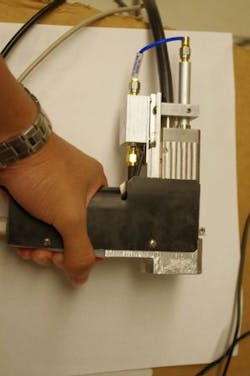Handheld photoacoustic microscopy device could enable deeper melanoma imaging
Researchers at Washington University in St. Louis (WUSTL; St. Louis, MO) have developed a handheld photoacoustic microscopy device that can be used directly on a patient and accurately measure how deep a melanoma tumor extends into the skin, providing valuable information for treatment, diagnosis, or prognosis.
Related: Converting molecular vibration to mechanical for deep-tissue imaging
Dermatologist Lynn Cornelius, one of the study's coauthors, explains that the thicker the melanoma tumor, the more likely it will spread and the deadlier it becomes. So the ability to measure the depth of the tumor in vivo enables doctors to determine prognoses more accurately—potentially at the time of initial evaluation—and plan treatments and surgeries accordingly.
Current methods are unable to directly measure a patient's tumor very well; because skin scatters light, high-resolution optical techniques don't reach deep enough. "None are really sufficient to provide the 2-4 mm penetration that's at least required for melanoma diagnosis, prognosis, or surgical planning," says engineer Lihong Wang, another coauthor of the study.
Other methods aren't much better: High-frequency ultrasound doesn't have enough image contrast, and magnetic resonance imaging (MRI) and positron emission tomography (PET) have insufficient resolution and require expensive, bulky instruments.
"Any type of tissue diagnosis at this point in time requires taking tissue out of the person and processing it and looking at it under the microscope," Cornelius says. But because taking a biopsy often only involves the removal of a part of a tumor—when it's in a cosmetically sensitive area, for instance—provisional measurements of the tumor depth are not always reliable. If, at the time of excision, the surgeon finds that the tumor goes deeper than initially thought, the patient may need yet another surgery.
Photoacoustic microscopy, however, can accurately measure melanoma tumors directly on a patient's skin—thus allowing doctors to avoid uncertainty in some circumstances. The technique relies on the photoacoustic effect, in which light is converted into vibrations. In the case of the new device developed by the WUSTL team, a laser beam shines into the skin at the site of a tumor. Melanin, the skin pigment that's also in tumors, absorbs the light, whose energy is transferred into high-frequency acoustic waves. Unlike light, acoustic waves don't scatter as much when traveling through skin. Tumor cells will produce more melanin than the surrounding healthy skin cells and, as a result, the acoustic waves can be used to map the entire tumor with high resolution. The device has a detector that can then turn the acoustic signal into a three-dimensional image on a screen.
Wang, Cornelius, and their colleagues previously built a similar desktop device, which shines the laser directly onto the tumor. But so much light is absorbed that very little penetrates to the tumor's lower layers. The latest version, however, is handheld and also delivers light around and below the tumor, generating a bright image of the tumor's bottom and an accurate measurement of its depth.
The researchers tested their device on both artificial tumors made of black gelatin and on real ones in live mice, showing that the instrument could accurately measure the depths of tumors—and do it in living tissue.
Initially, this tool will be mainly used for improving how doctors plan and prepare for surgeries, Cornelius says. But what's especially exciting, she adds, is that it can measure a tumor's entire volume—something that's never been possible with melanoma. If researchers can determine how the volume relates to cancer outcomes, then this tool could give doctors a new type of measurement for diagnosis and prognosis.
The researchers are now conducting further tests with human patients. The new device will have to prove effective in clinical trials before it is widely available. But other than that, Wang says the device is essentially ready for commercialization.
Full details of the research team's work appear in the journal Optics Letters; for more information, please visit http://dx.doi.org/10.1364/OL.39.004731.
-----
Don't miss Strategies in Biophotonics, a conference and exhibition dedicated to development and commercialization of bio-optics and biophotonics technologies!
Follow us on Twitter, 'like' us on Facebook, and join our group on LinkedIn
Subscribe now to BioOptics World magazine; it's free!

